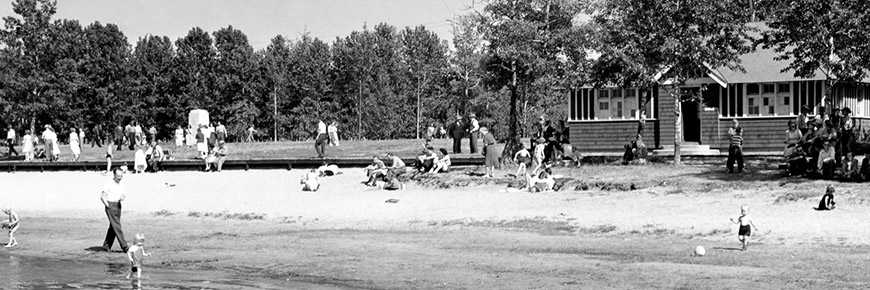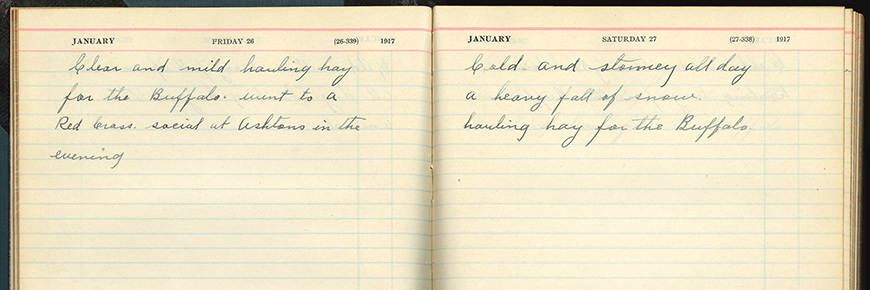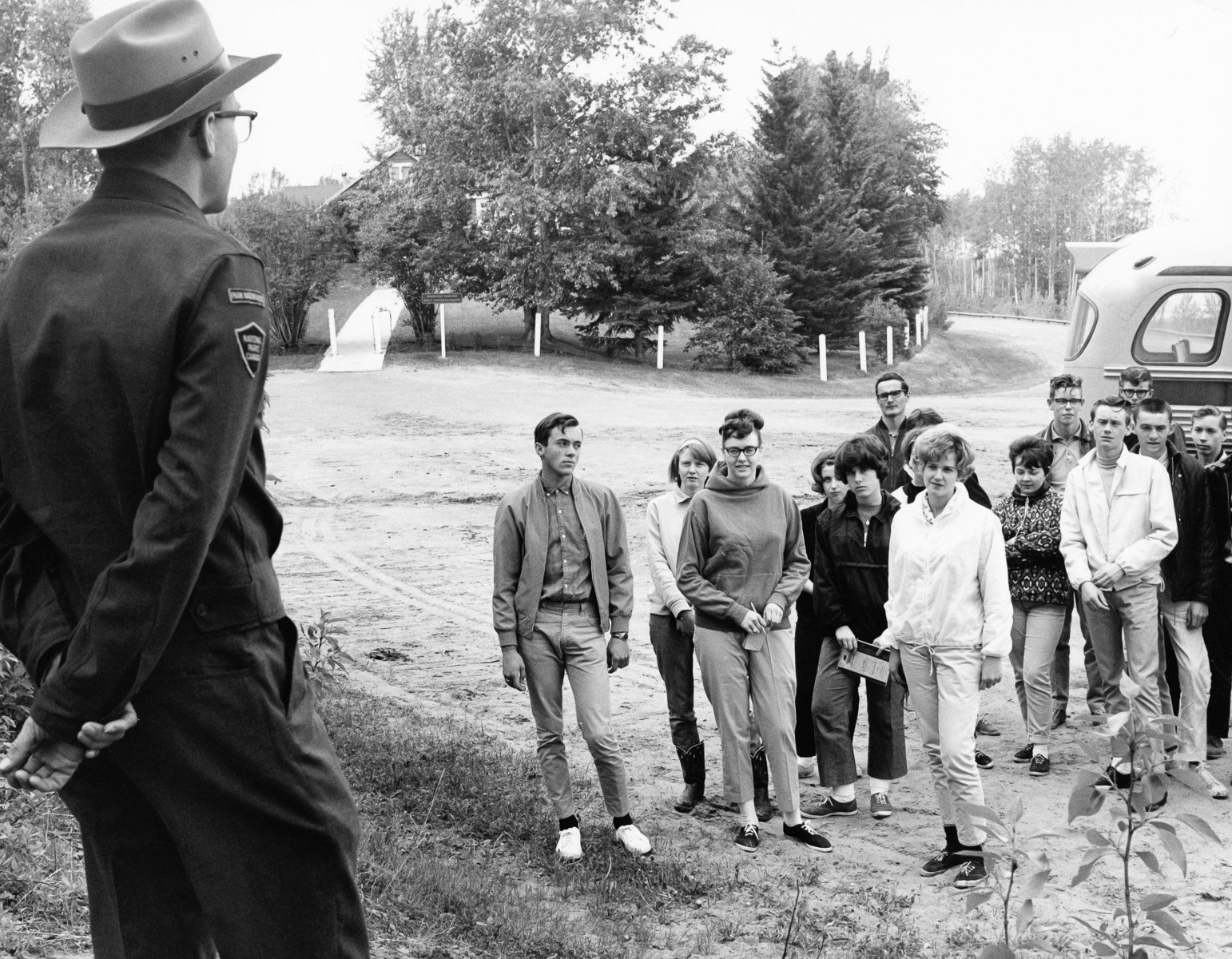
View of Astotin Lake from the original highway to the park circa 1920
Park history
Elk Island National Park
While some may assume most national parks in Alberta are situated in remote scenic areas with mountains and pristine lakes, Elk Island National Park, the only full-enclosed national park, is located just 35 minutes east of Edmonton. Founded in 1906 as an elk preserve to protect one of the last big elk herds in the region, it was the first wildlife refuge in Canada. For more than a century, the park has drawn visitors to its natural setting thanks to easy access to Edmonton and an abundance of wildlife viewing opportunities.
Being Canada’s sixth oldest of forty-six national parks, Elk Island National Park is situated in the Amiskwaciy, which is the Cree word for this region, and is otherwise known in English as the Beaver Hills. It is an area, as the name suggests, abundant in beaver before the turn of the 19th century when the species was nearly extirpated from the area due to demands of the fur trade. What made the Beaver Hills unique was the aspen thickets which surrounded the prairie and provided forage and protection for the wintering herds of bison and year-round population of elk, moose and deer. There was also plenty of water. The “Island” in Elk Island’s name may have originated as a reference to the picturesque islands dotting Astotin Lake.

The chronology of Elk Island National Park
1830s to 1900s
The Beaver Hills became an important centre for much of the commercial hunting, which supplied the fur trade. Beaver were virtually eliminated from the Beaver Hills by the 1830s. As late as 1841 bison were still being obtained in large numbers from the Beaver Hills. But they were quickly being depleted. By the late 1860s, the numbers of large ungulates were depleted to the point where the bison were almost eliminated and other large herbivores were very scarce.
Most of the lands in the Beaver Hills remained untouched from the 1870s through the homestead period. The remaining forest resources were viewed by some as a valuable timber resource; by others as a hindrance to settlement. In 1895 fire devastated the area. This prompted the federal government to protect the forest and in 1899 the area was officially designated as 'The Cooking Lake Forest Reserve.'
Although the forest was protected, the elk and mule deer were not. Sport hunting and hunting for meat by the settlers posed a threat to wildlife populations. Those elk which were present in the Beaver Hills were considered one of the last herds in Canada.
Early 20th century at a glance
1906
Elk Island was founded, initially, as an elk preserve to protect one of the last big elk herds in the region. Five Albertans from the Fort Saskatchewan area persuaded the federal government to create a wildlife sanctuary for the elk of the Beaver Hills. The government responded with the new Dominion Forest Reserve Act which established 'Elk Park' July of 1906. A 2.2 metre fence was constructed around the area, which included the area around present day Astotin Lake. It was the first wildlife refuge in Canada.
Elk Park, 42 square km (16 sq. mi.) established with herd of 24 elk, 2 to3 moose and 35 mule deer. Foundation of today's main park population.
1907
The Canadian Government purchased one of the last and largest remaining plains bison herds. Hundreds of bison from the Pablo-Allard herd of Montana were shipped to Elk Island for holding before being sent to Buffalo National Park near Wainwright, Alberta.
The superintendent’s residence was built for the park’s first superintendent, Ellsworth Simmons. It is the oldest surviving building in the park.
1908
Elk Park becomes known as Elk Island Park.
1909
Approximately forty bison remained in Elk Island when the Pablo-Allard herd was being transferred to Buffalo National Park. Members of today’s herd are the descendants of those few animals.
1912
The last shipment of the Pablo-Allard herd arrived by train.
1913
Elk Island Park was designated as a Dominion Park—part of Canada growing national parks system.
1920s buffalo riders and bison robes
1920s
From the park’s founding, until it was expanded down to what is now the Yellowhead Highway, the west gate served as the main entrance to the park.
1922
Area south to current day Highway 16 (Yellowhead Highway) added to reduce impact of overgrazing.
1923
As part of a system of warden’s cabins at the park, the Tawayik warden station was built on the site of the current Visitor Information Centre.
1920s to 1960s
The barn was home to working horses that patrol and protect Canada’s western national parks.
Bison robes from the park’s herd were worn by the RCMP as winter coats.
The park’s bison became a source of bison supplies such as pemmican. Pemmican is a mixture of dried bison meat, fat, and berries.
1930s dust and dance halls
1930
Elk Island re-designated as a national park under the National Parks Act.
1930s
During the Great Depression, unemployed men in labour relief camps worked to build infrastructure in many of Canada’s national parks. At Elk Island National Park, they cleared land, built roads, and constructed the boundary fence along the park’s various buildings such as the historic pavilion. They worked hard during the harsh winter months and sheltered in tents.
Private and rental cabins, a dance hall, a youth hostel, and the Pavilion were built.
1936
The Elk Island National Park Golf Course was built. It is one of the oldest golf courses in Alberta.
preserving the herds
1942 to 1946
B.I. Love, the park’s superintendent and a visionary veterinarian, initiated testing and translocating disease-free bison. The first round up of 12,000 plains bison were tested for tuberculosis.
1942
Almost trapped to extinction by the early 1800s during the fur trade, the beaver was reintroduced to the park. The population grew rapidly. Today, there are as many as 350 active beaver lodges.
1943
The Historic Sites and Monuments Board of Canada erected a plaque to commemorate the conservation of the plains bison.
1947
Elk Island National Park expanded to include 60 sq km south of Highway 16 (Yellowhead Highway)-today known as the Wood Bison Area.
1965
A newly-discovered isolated herd of wood bison were brought to Elk Island to preserve their unique genetics.
1980s swans and saints
1972
Elk Island’s bison herds were declared disease-free and free of cattle genes.
1984
As part of his Canadian tour, Saint John Paul II visited the Tawayik area of Elk Island National Park.
1987
The once-endangered trumpeter swan was reintroduced to the park through the Transplant program.
1988
Wood bison down-listed from 'rare' to 'threatened' species.
2006 and beyond
2006
Elk Island National Park celebrated its 100th Anniversary. It also remains Canada’s only completely fenced national park.
The Beaver Hills Dark Sky Preserve was designated by the Royal Astronomical Society of Canada and encompasses Elk Island National Park and neighbouring protected areas.
2016
The Beaver Hills area, which includes Elk Island National Park, was designated a UNESCO Biosphere Reserve. It is recognized globally for the community’s commitment to conservation and sustainable development.
A spiritual homecoming. Eighty-seven plains bison (descendants of the Pablo-Allard Montana herd) were relocated to the Blackfeet Nation Reservation in Montana, the herd’s ancestral home.
2017
Canada celebrated the 150th anniversary of Confederation.
After being absent from the wild in Banff for over a century, 16 plains bison were successfully translocated from Elk Island National Park to the Panther Valley in Banff National Park.
2018
On Earth Day (April 22) the first bison calf from the Elk Island National Park reintroduction is born in Banff National Park.
The bison herd, translocated from Elk Island National Park to the Panther Valley in 2017 are released from pasture in July and free to cross the rivers and roam the valleys of Banff National Park with their newborn young.
Elk Island National Park initiates grassland ecosystem restoration that includes returning prescribed fire to the landscape.

The Warden’s journals

For over a century, the wardens of Elk Island National Park have protected and served this special place.
During the early years of the park, the warden kept journal entries that recorded daily events, elk, bison, and other animals’ health and population numbers, as well as the weather and special events.
From the mid-1970s to 2008, park wardens played many different roles. Their duties involved visitor safety, law enforcement, resource conservation, addressing human-wildlife conflicts, as well as science monitoring and fire management. In 2008, the role of a park warden became specialized and dedicated to law enforcement.
Discover more by looking at some of the original journal entries made by Elk Island National Park wardens at the Visitor Information Centre.
- Date modified :